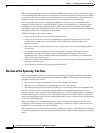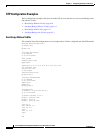
8-5
Cisco IOS Software Configuration Guide for Cisco Aironet Access Points
OL-29225-01
Chapter 8 Configuring Spanning Tree Protocol
Understanding Spanning Tree Protocol
BPDUs contain information about the sending access point/bridge and its ports, including access
point/bridge and MAC addresses, access point/bridge priority, port priority, and path cost. STP uses this
information to elect the spanning-tree root and root port for the network and the root port and designated
port for each LAN segment.
Spanning-Tree Timers
Table 8-1 describes the timers that affect the entire spanning-tree performance.
Creating the Spanning-Tree Topology
In Figure 8-1, bridge 4 is elected as the spanning-tree root because the priority of all the access
point/bridges is set to the default (32768) and bridge 4 has the lowest MAC address. However, because
of traffic patterns, number of forwarding interfaces, or link types, bridge 4 might not be the ideal
spanning-tree root. By increasing the priority (lowering the numerical value) of the ideal bridge so that
it becomes the spanning-tree root, you force a spanning-tree recalculation to form a new topology with
the ideal bridge as the spanning-tree root.
Figure 8-1 Spanning-Tree Topology
Table 8-1 Spanning-Tree Timers
Variable Description
Hello timer Determines how often the access point/bridge broadcasts hello messages to other access
point/bridges.
Forward-delay timer Determines how long each of the listening and learning states last before the interface begins
forwarding.
Maximum-age timer Determines the amount of time the access point/bridge stores protocol information received on an
interface.
LAN segment A
LAN segment B
Bridge 1
Bridge 3
Bridge 2
Bridge 4
56612


















